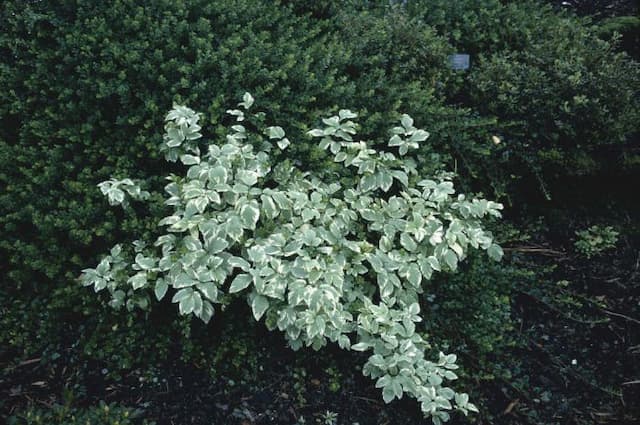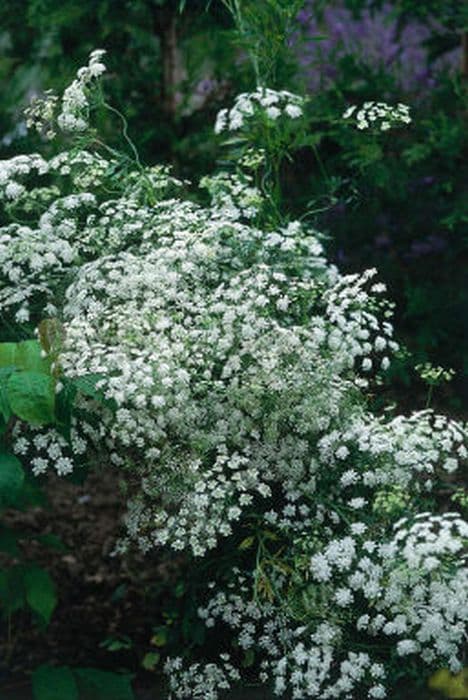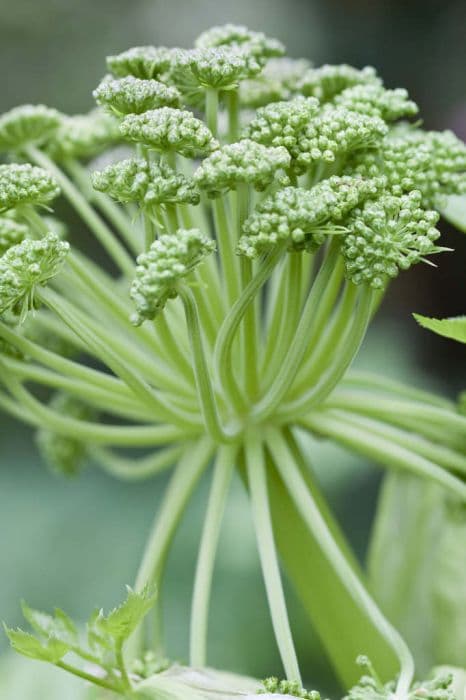Great Masterwort Astrantia major 'Pink Surprise'

ABOUT
Astrantia major 'Pink Surprise', commonly known as Great Masterwort, is an herbaceous perennial that showcases a charming appearance in the garden. The plant is recognized for its distinctive flowers which are a star attraction. These blooms present a captivating visual with their pink-hued, pincushion-like central florets that are intricately framed by a ruff of papery bracts, creating a lacey effect. These bracts often exhibit a paler pink or sometimes white shade with hints of green, which subtly highlights the richer pink of the central florets. Great Masterwort's foliage is equally elegant, comprising deeply lobed, palmate leaves that are a rich green in color. The leaves form a lush mound that serves as a delightful backdrop for the pretty floral display that perches atop slender stems, seemingly floating above the greenery. Adding to its grace, the individual stems that bear the flowers create a sense of airy lightness, as they are intricately branched, giving the plant a delicate and intricate structure. The overall appearance of Astrantia major 'Pink Surprise' is one of a refined and structured beauty, making it a coveted addition to borders and cottage garden settings. Its unique flowers and attractive foliage contribute to an aesthetic that is both romantic and sophisticated.
About this plant
 Names
NamesFamily
Apiaceae
Synonyms
Masterwort, Great Masterwort, Hattie's Pincushion, Melancholy Gentleman
Common names
Astrantia major 'Pink Surprise'.
 Toxicity
ToxicityTo humans
Great Masterwort (Astrantia major 'Pink Surprise') is not known to be toxic to humans. However, as with any plant, individual reactions can vary and it's generally advised not to ingest plants that are not commonly recognized as food, due to potential unknown allergic reactions or other adverse effects.
To pets
Great Masterwort (Astrantia major 'Pink Surprise') is also not known to be toxic to pets. It is always advisable to prevent pets from eating ornamental plants since they might cause gastrointestinal upset or an allergic reaction in some sensitive animals, even if the plant is not considered highly toxic.
 Characteristics
CharacteristicsLife cycle
Perennials
Foliage type
Deciduous
Color of leaves
Green
Flower color
Pink
Height
2 feet (60 cm)
Spread
1 foot (30 cm)
Plant type
Herb
Hardiness zones
4
Native area
Europe
Benefits
 General Benefits
General Benefits- Attracts Pollinators: Astrantia major 'Pink Surprise' is known to attract bees and butterflies, which are vital for pollination.
- Low Maintenance: It is a hardy perennial that requires minimal care once established in the garden.
- Drought Tolerance: Once established, it can tolerate periods of drought, making it suitable for various climates.
- Long Blooming Time: The plant has a long flowering season, often from early summer to late fall.
- Aesthetic Appeal: With its unique pink pincushion-like flowers and attractive foliage, it adds visual interest to any garden.
- Versatile Garden Use: Perfect for borders, cottage gardens, and as filler in mixed beds.
- Cut Flowers: The blooms make excellent cut flowers, lasting well in a vase and adding elegance to floral arrangements.
- Deer Resistant: Typically not favored by deer, making it a good choice for gardens in areas with deer populations.
 Medical Properties
Medical PropertiesThis plant is not used for medical purposes.
 Air-purifying Qualities
Air-purifying QualitiesThis plant is not specifically known for air purifying qualities.
 Other Uses
Other Uses- Art and Crafting Material: The starry shapes and striking colors of masterwort flowers can be pressed and used in crafting for creating natural art pieces or adding a delicate touch to homemade paper.
- Drying for Decor: Masterwort blooms dry exceptionally well, retaining shape and color, making them perfect for creating long-lasting floral arrangements and dried bouquets.
- Garden Photography: The unique aesthetic of masterwort makes it a sought-after subject for garden photographers looking to capture the intricacy of garden plant species.
- Educational Resource: Masterwort is interesting for botanical studies due to its unique inflorescence, providing a learning example of umbel-shaped flower structures.
- Landscape Design: With its textured foliage and vibrant flowers, masterwort can be used to add depth and color contrast in garden landscape designs.
- Garden Borders: Masterwort's clumping growth pattern and attractive foliage make it an excellent choice for creating visually appealing garden borders and edges.
- Companion Planting: Masterwort can be used in companion planting to help highlight the colors and textures of surrounding plants, creating a more diverse and attractive garden space.
- Nature-Inspired Art: The form and structure of masterwort can serve as an inspiration for artists and designers looking to mimic natural forms in their work.
- Floral Language and Symbolism: In the language of flowers, masterwort can be gifted to represent courage and strength, making it a meaningful addition to bouquets with a message.
- Culinary Garnish: Although not widely recognized for culinary use, the flowers can be used as a decorative garnish for special dishes in high-end culinary presentations.
Interesting Facts
 Feng Shui
Feng ShuiThe Great Masterwort is not used in Feng Shui practice.
 Zodiac Sign Compitability
Zodiac Sign CompitabilityThe Great Masterwort is not used in astrology practice.
 Plant Symbolism
Plant Symbolism- Protection: Astrantia major, commonly known as Great Masterwort, has been associated with protection due to its intricate star-shaped flowers, which were believed to ward off evil.
- Perseverance: It thrives in challenging environments, symbolizing the ability to endure and persist through difficulties.
- Mystery and Magic: The unique appearance of the Great Masterwort's flowers lends it an aura of the mystical, often associated with enchantment and secret gardens.
- Unity: The clustered blooms of the Great Masterwort symbolize togetherness and unity, reflecting the plant's natural growth in harmonious clusters.
- Strength: The robust nature of Astrantia major reflects strength and resilience, making it emblematic of a steadfast character.
 Water
WaterGreat Masterwort 'Pink Surprise' prefers consistently moist soil, so water it thoroughly whenever the top inch of soil feels dry. Typically, this means watering at least once a week, but frequency should be increased during hot, dry spells. Aim to provide the plant with about 1 gallon of water per week, depending on weather conditions and soil type. Avoid overhead watering to keep the foliage dry and prevent fungal diseases. Ensure good drainage to prevent waterlogging, which can harm the plant.
 Light
LightGreat Masterwort 'Pink Surprise' thrives best in partial shade. It should be placed in a spot where it receives dappled sunlight or light shade, especially sheltered from the intense heat of the afternoon sun. The gentle morning sun is ideal for promoting healthy growth and flowering without causing stress to the plant.
 Temperature
TemperatureGreat Masterwort 'Pink Surprise' can tolerate a wide range of temperatures but grows best when the daytime temperature is between 65 and 75 degrees Fahrenheit. It can survive minimum temperatures down to about 0 degrees Fahrenheit, making it suitable for many temperate regions. Ensure that the plant is protected from extreme heat, as temperatures consistently above 85 degrees Fahrenheit can stress the plant.
 Pruning
PruningGreat Masterwort 'Pink Surprise' should be pruned to remove spent flowers and encourage a second bloom, typically after the first flush of flowers fades in early summer. Pruning can also be done to shape the plant and maintain a desirable size. Cut the stems back to just above a set of leaves, and perform this task yearly, ideally after the main flowering period.
 Cleaning
CleaningAs needed
 Soil
SoilMasterwort prefers a soil mix that is rich, moist, and well-draining with a pH of 5.8 to 6.8. A mixture containing garden soil, compost, and a little sand would be ideal to provide the nutrients and drainage that Astrantia major 'Pink Surprise' needs for optimal growth.
 Repotting
RepottingMasterwort, being a perennial, does not need frequent repotting and is often repotted only when it outgrows its current container, which could happen every 2 to 3 years.
 Humidity & Misting
Humidity & MistingMasterwort thrives best in average to high humidity conditions but is quite adaptable, making it suitable for a range of garden environments.
 Suitable locations
Suitable locationsIndoor
Place in bright, indirect light with moist soil.
Outdoor
Choose a shaded spot with moist soil and protect from afternoon sun.
Hardiness zone
4-7 USDA
 Life cycle
Life cycleAstrantia major 'Pink Surprise', commonly known as Great Masterwort, begins its cycle as a seed which germinates in the spring when soil temperatures become suitable. After germination, the seedling phase involves the development of a small rosette of leaves at ground level. As the plant enters the vegetative stage, it produces a larger, more substantial rosette of deeply divided leaves, establishing a strong root system. Once mature, typically in late spring to early summer, it advances to the flowering stage where it produces unique pink-shaded blooms with a pincushion-like appearance, surrounded by a star-like bract. Following pollination by insects attracted to the flowers, the plant produces seed heads that mature by late summer or early fall, dispersing seeds for the next generation. The plant then dies back to its perennial rootstock in winter, resting until the next growth cycle begins in spring.
 Propogation
PropogationPropogation time
Early spring to early summer
The Astrantia major 'Pink Surprise', commonly known as Masterwort, is best propagated through division. Propagation time usually occurs in early spring or late autumn once the plant has become dormant. You would begin first by lifting the plant out of the ground with a spade, ensuring a generous amount of soil is kept around the roots. Carefully tease apart the plant clumps into smaller sections, each with their own set of roots and shoots. Replant these sections immediately into well-prepared soil, ideally at the same depth they were growing before, and water them thoroughly. This method encourages the development of a strong root system, which is key to the health and growth of new Masterwort plants.









